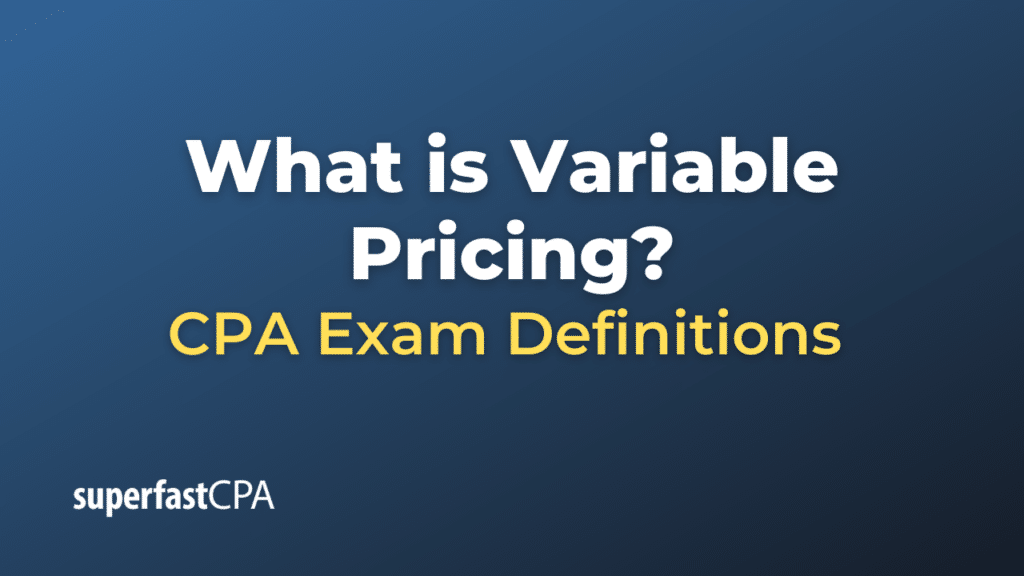Variable Pricing
Variable pricing refers to a pricing strategy where a business sets flexible prices for its products or services rather than fixing them at a single price point. Variable pricing allows businesses to charge different prices based on various factors such as demand, customer segments, market conditions, or time of purchase. This approach contrasts with fixed pricing, where a product or service is sold at a set price regardless of circumstances.
Here are some common types of variable pricing:
Prices change in real-time based on supply and demand. Common in industries like airlines, hotels, and ride-sharing services. For example, an airline might charge higher prices for flights during peak travel seasons or when there are fewer seats available.
Time-based Pricing
Prices vary depending on when a customer makes a purchase. Restaurants may offer early-bird specials, and utilities might charge lower rates during off-peak hours.
Customer-based Pricing
Prices differ based on customer characteristics. For example, students and seniors might get discounted movie tickets, or software companies may offer lower prices for educational institutions.
Location-based Pricing
The price varies depending on where a customer is located. For example, ride-sharing services might charge more for pickups in high-demand areas.
Pay-What-You-Can or Pay-What-You-Want
Customers choose the price they are willing to pay, often seen in industries like digital music or software, and sometimes as a promotional strategy.
Tiered Pricing
Different versions of a product are offered at different price points. For example, a software company might offer a basic version for free, a professional version with more features at a moderate price, and an enterprise version with all available features at a high price.
Bundle Pricing
A combination of products is sold together at a lower price than if each product were purchased separately. This is common in the telecom industry, where phone, internet, and television services may be bundled.
Seasonal Pricing
Prices are adjusted based on the season or time of year. For instance, ski resorts might charge higher prices during the winter season compared to the summer off-season.
Variable pricing allows businesses to maximize revenue, better match supply with demand, and target different customer segments more effectively. However, it can also complicate the purchasing decision for customers and potentially lead to perceptions of unfairness if not managed carefully.
Example of Variable Pricing
Let’s explore an example using the ride-sharing industry, which frequently employs dynamic variable pricing, also known as “surge pricing.”
Scenario:
Imagine you’re using a ride-sharing app like Uber or Lyft. The app uses dynamic pricing based on real-time supply and demand. The pricing can change minute-by-minute based on various factors such as the number of available drivers, the number of people requesting rides, weather conditions, and even special events happening in the area.
Normal Pricing:
- On a regular day with average demand and supply, the ride from your home to the airport might cost you $20.
Scenario 1: High Demand (Rush Hour)
- One morning, you need to get to the airport during rush hour. The demand for rides is high, but there are fewer available drivers.
- The app informs you that surge pricing is in effect and the same ride now costs $40.
Scenario 2: Special Event (Concert Night)
- On another occasion, you decide to use the service to get home from a concert. Since many people are leaving the concert at the same time and requesting rides, the app’s dynamic pricing kicks in.
- The price for the ride home surges to $50 due to the exceptionally high demand.
Scenario 3: Low Demand (Midday, Midweek)
- Conversely, you find that taking a ride midday in the middle of the week, when demand is typically low, costs you only $18, slightly less than the usual rate.
Summary:
In each of these scenarios, the ride-sharing company uses variable pricing to balance supply and demand. When demand is high and supply is low, prices increase, incentivizing more drivers to offer rides. Conversely, when demand is low, prices might decrease to attract more riders.
This dynamic, variable pricing model allows the ride-sharing service to maximize its revenue and better match supply and demand. However, it also means that customers have to be aware that the cost of the service can vary widely depending on when and how they use it.













